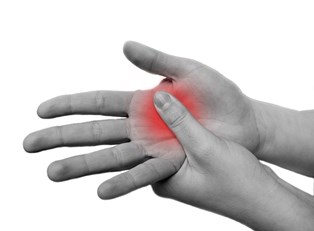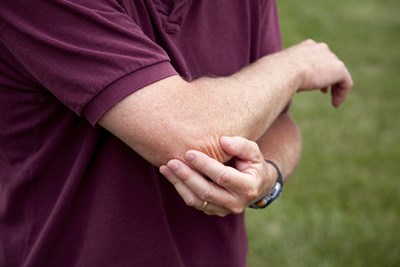Osteoarthritis (degenerative joint disease; osteoarthrosis) is the most common form of arthritis, affecting nearly 21 million Americans. It occurs when cartilage in one's joints degrade over time, usually in the hands, wrists, hips, knees, neck and lower back. Cartilage is a firm, but elastic, material that reduces friction in the joints to serve as a natural shock absorber.
Osteoarthritis causes the cartilage to stiffen, making it susceptible to damage and deterioration over time. The nearby tendons and ligaments stretch in reaction to this, and if the cartilage wears down completely, bone may rub against bone, which damages the ends and causes joint pain. Osteoarthritis symptoms develop slowly and become more severe over time. Researchers suspect the cause of mechanical stress, which leads to cartilage deterioration, is a combination of factors including the natural aging process, joint injury or stress (torn ligaments, strained muscles, dislocated joints), heredity, muscle weakness, and obesity. According to the Arthritis Foundation, over twenty million Americans, and 70-90% of the population over the age of seventy-five, are affected by osteoarthritis. Osteoarthritis symptoms occur earlier in women (around 50-55). The chance of developing the disease increases with age, but even people in their 20s and 30s can develop the condition.
Osteoarthritis Medical Treatment
Osteoarthritis medical treatment begins with medications that reduce the pain and inflammation. In order to achieve the best results and most accurately manage pain and slow joint degradation, individuals should take medications exactly as prescribed by their healthcare providers. A common medication prescribed for osteoarthritis is Tramadol (Ultram), which is a centrall acting analgesic with no anti-inflammatory effect but can provide pain relief. It is known, however, to cause nausea and constipation and is generally used short-term for flare-ups. It can be used in combination with acetaminophen (Tylenol). Prescription pain killers, such as codeine, may provide relief from severe osteoarthritis pain but carry a risk of dependence, nausea, constipation, and sleeplessness. Injections of corticosteroid medications (cortisone) also may relieve joint pain. This procedure involves a numbing of the skin around the joint, then inserting a needle into the joint cavity to directly inject the medication. Too many of this type of injection may actually cause further joint damage. Other medical treatment may come in the form of working with a physical therapist to learn ways to complete daily tasks without over-stressing joints. In the most severe cases, joint replacement surgery (arthroplasty), or surgical bone realignment or bone fusion may be recommended osteoarthritis medical treatment.



